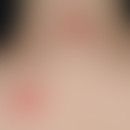Synonym(s)
HistoryThis section has been translated automatically.
Buschke, 1900
DefinitionThis section has been translated automatically.
Rare, scleroderma-like, potentially reversible, cutaneous-subcutaneous mucinosis (see mucinoses), which can occur with various etiologically significant concomitant diseases/symptoms (streptococci - mycoplasma infections; diabetes mellitus, paraproteinemia, carcinoid tumours) as well as during pregnancy.
You might also be interested in
EtiopathogenesisThis section has been translated automatically.
Three different forms are distinguished according to the disease trigger or associated underlying diseases:
- Type I Occurs after infections, especially streptococcal infections. This form is often self-limiting and occurs in younger women and in childhood. Type I also includes cases in HIV infection (Yachoui R et al. 2013).
- Type II occurrence in patients with monoclonal gammopathy (middle-aged men).
- Type III association in patients with diabetes mellitus and metabolic syndrome. These patients usually have obesity per magna. Occurrence in middle-aged men.
ManifestationThis section has been translated automatically.
see above
LocalizationThis section has been translated automatically.
ClinicThis section has been translated automatically.
Type I (middle-aged women and children):
- Sudden onset with or after streptococcal infection (often respiratory tract) with feeling of illness, fever, extensive, hard, edematous, superficial nodular or wavy swelling.
- The skin cannot be lifted off in folds, cannot be pressed in.
- Breathlessness due to the balloon-like bulging of the skin.
- Restriction of the mobility of the arms in abduction and flexion position. The face may be affected, which manifests itself in amimia and difficult mouth opening.
- In rare cases, internal organs (oesophagus, pericardium, joints, pleura, heart muscle, skeletal muscle) are involved.
Type II
- Clinical like type I, without febrile prodromal stage with evidence of paraproteinemia (MGUS)
type III
- This form occurs in middle-aged men with insulin-dependent diabetes mellitus. The skin lesions are mainly found on the trunk (back) and neck. They are often not perceived as "pathological" by the patients.
HistologyThis section has been translated automatically.
Differential diagnosisThis section has been translated automatically.
TherapyThis section has been translated automatically.
There is no generally accepted therapy known. In any case, it will have to be adapted to the underlying disease.
With Type I, therapy is not absolutely necessary, as the disease is self-limiting.
- High-dose treatment with immunoglobulins (IVIG therapy) is recommended
- Alternatively penicillamine (metalcaptase) 450-600 mg/day p.o. (effects doubtful)
- Alternative: PUVA therapy (also as complementary topical therapy to a systemic therapy)
- In severe cases glucocorticoids (e.g. Decortin) 40-80 mg/day on a trial basis, long-term therapy by 5-20 mg/day according to clinic (Cave: Type III).
In type II, treatment of the underlying disease (paraproteinemia) is recommended.
In type III a good control of diabetes mellitus is required, although a connection between diabetes control and improvement of the skin symptoms is often not evident.
Supplementary: Successes with PUVA, UVA-1, narrow spectrum UVB and bathing PUVA therapy have been reported (Kohn D 2018).
General: Physical measures to maintain the ability to move, see below scleroderma.
Progression/forecastThis section has been translated automatically.
Type I is self-limiting. Restitutio ad integrum after months to years probably.
Case report(s)This section has been translated automatically.
Anamnesis: The 72-year-old patient had noticed for years an increasing, not painful, only tense hardening of the skin on the trunk, here especially in the area of the shoulder girdle. An earlier examination revealed the finding of a deep morphea. Known diabetes mellitus requiring insulin.
Skin findings: unusually flat (board) hard, not reddened induration of the entire back area. Also on buttocks and thighs. Abdomen not affected.
Histology: thickened reticular dermis with broad turgid collagen fiber bundles, no cell proliferation. Minor perivascular infiltrates with lymphocytes, plasma cells, mast cells. Metachromasia with toluidine blue and alzian blue.
Laboratory: free kappa light chains in serum: 5.6mg/l (norm: 3.3-19.4). Free lambda light chains in serum: 360mg/l (norm: 5.70-26.3).Protein in urine: 150mg/l; evidence of Bence-Jones proteinuria.
Therapy: this was not necessary from hemato-oncological point of view at the time of presentation.
LiteratureThis section has been translated automatically.
- Aichelburg MC et al (2012) Successful treatment of poststreptococcal scleredema adultorum Buschke with intravenous immunoglobulins. Arch Dermatol 148:1126-1128
- Alp H et al (2003) Scleredema adultorum due to streptococcal infection. Pediatr Int 45: 101-103
- Barde C et al (2009) Scleroedema adultorum Buschke in a diabetic subject: intravenous immunoglobulin therapy. Ann Dermatol Venereol 136:360-363
- Buschke A (1900) Presentation of a case of scleroedema to the Berlin Society of Dermatology. Arch Dermatol Syph 52: 383
- Grundmann-Kollmann M et al (2000) Cream PUVA therapy for scleredema adultorum. Br J Dermatol 142: 1058-1059.
- Happe S et al (2002) Buschke adult scleredema as a rare differential stiff-man syndrome diagnosis. Nervenarzt 70: 916-919
- Jacob N et al (2002) Scleredema adultorum in secondary hyperparathyroidism. Dermatologist 53: 121-125
- Kohn D (2018) S cleroedema diabeticorum. Dermatologist 68: 929-931
- Rani JD et al (2012) Juvenile scleredema of Buschke. J Contemp Dent Pract 3:111-114
- Venencie PY et al (1984) Scleredema: a review of thirty-three cases. J Am Acad Dermatol 11: 128-134.
- Wu JI et al (2009) Scleredema adultorum of Buschke associated with a carcinoid tumor. Int J Dermatol 48:784-786
- Yachoui R et al (2013) Scleredema in a patient with AIDS-related lipodystrophy syndrome. Case Rep Endocrinol 943798. doi: 10.1155/2013/943798.
Incoming links (12)
Adiposity skin changes; Buschke, abraham; Cellulitis sclerosiformis extensiva benigna; Lichen myxedematosus and HIV-Infection ; Lipedema syndrome, painful; Pseudoscleroderma; Scleroderma bushke; Sclérodermie oedémateuse; Scleroedema bush turkey; Sclerosis;; ... Show allOutgoing links (9)
D-Penicillamine; Fasciitis eosinophil; Glucocorticosteroids; Mucinosis cutaneous (overview); Puva bath therapy; Scleroderma (overview); Scleroderma systemic; Subcutis; Uva-1 therapy;Disclaimer
Please ask your physician for a reliable diagnosis. This website is only meant as a reference.









